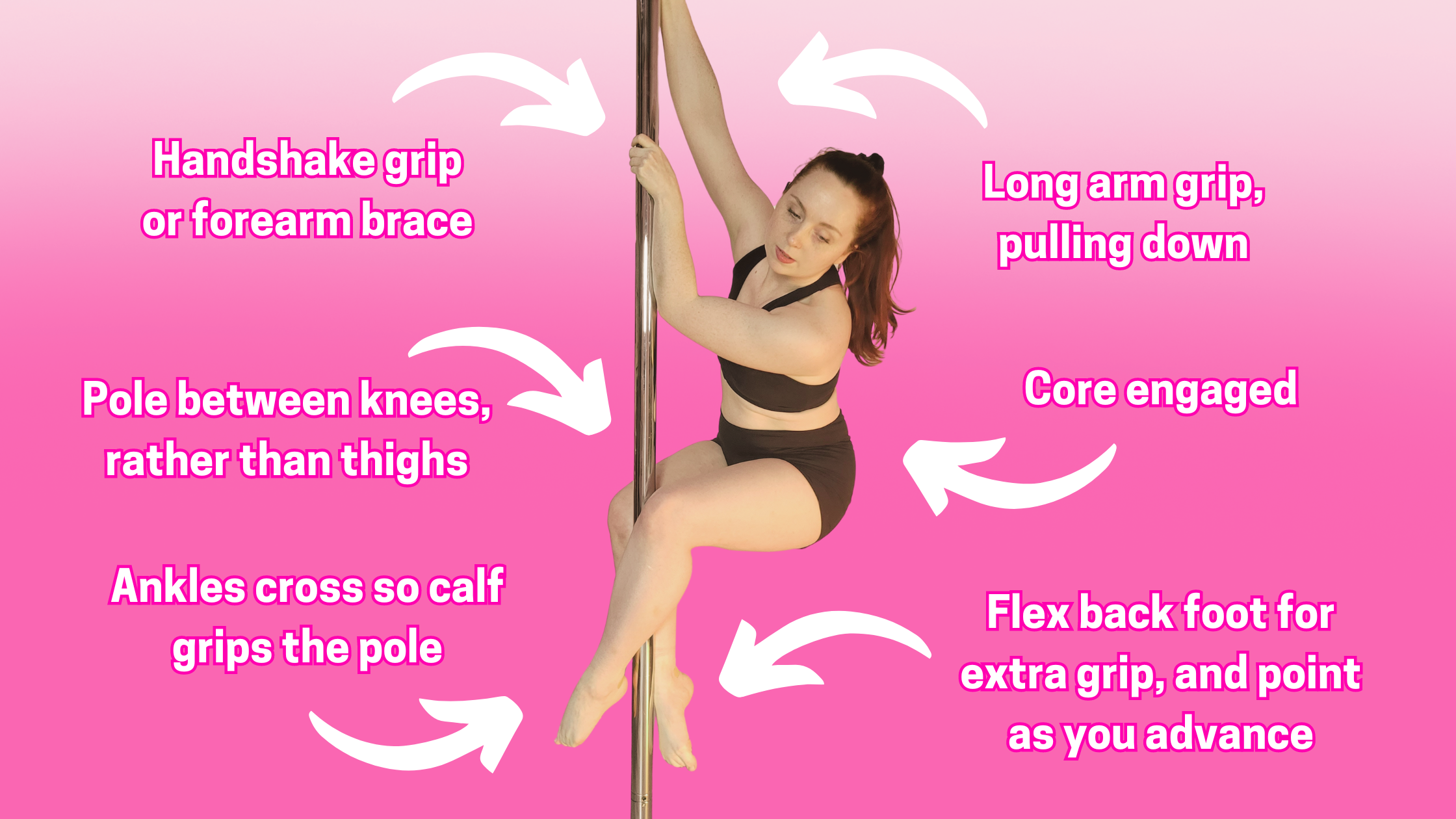To improve your pole dance climb, focus on strengthening your core and upper body, and enhancing your grip technique. Consistent practice is essential.
Pole dancing is a dynamic and challenging form of exercise that requires strength, flexibility, and technique. Improving your pole dance climb can significantly enhance your overall performance and safety. Focus on building core, arm, and shoulder muscles, as these provide the foundation for effective climbing.
Enhancing your grip technique is also crucial; it ensures you can maintain your hold on the pole without slipping. Regular practice and proper training routines will help you master these skills, making your climbs more efficient and graceful. Whether you are a beginner or an experienced dancer, these tips can elevate your pole dancing abilities.
Pole Climbing Basics
Pole dance is a mix of strength, grace, and flexibility. Flexibility is vital to perform stunning moves and avoid injuries. Improving flexibility helps enhance your overall pole dance skills. It makes transitions smoother and helps you extend more into poses.
Grip Techniques
Flexibility offers several advantages for pole dancers:
Handshake Grip:
Wrap your hands around the pole like a handshake.Forearm Grip:
Use your forearm for support to brace against the pole. This grip helps keep the body away and makes moving the legs more efficient.Core Engagement
Engaging your core is vital for a successful climb. A strong core helps you maintain balance and control. Follow these steps to engage your core properly:
- Ensure your pelvic tilt is in neutral, so if you arch the back you will need to tilt the pelvis forward slightly.
- Ensure your ribs are not flaring forward, stack them over the pelvis.
- Imagine you are steaming up a pair of glasses to get the core ‘tightness’.
Watch our on-demand ‘what is core engagement?’ tutorial for a more in-depth look!
Foot Placement
Proper foot placement makes climbing easier. Follow these tips for the best foot positioning:
- Flex the Back Foot: When you first start learning to climb, flexing the back foot can help with grip
- Place Feet Firmly: Ensure your feet are securely placed, one in front and one behind, so the pole is wedged between your ankles
Leg Placement
Having the pole gripped in the right part and using your legs will aid in your climb. Follow these tips for the best foot positioning:
- Pole Between the Knees: The pole should be between the knees, rather than in the thighs.
- Push With Your Legs: Don’t be tempted to pull with your arms too early, allow your legs to do some of the work.

Pre-climb Warm-up Routines
Activating specific muscles is crucial for a successful climb. Focus on the muscles that support your climb. This includes your core, shoulders, and legs. Here are some effective muscle activation exercises:
- Plank Hold: Hold for 30 seconds to engage your core.
- Pole Pull Ups: Do 7 reps to activate arms and shoulder muscles.
- Squats: Perform 15 reps to engage leg muscles.
These targeted muscle activation exercises help prepare your body for the demands of pole dancing. Incorporate them into your routine to see improvements in your climb.
Strength Training for Pole Climbing
Improving your pole dance climb requires dedicated strength training. Building strong muscles helps you climb the pole with ease and grace. In this section, we’ll focus on key areas for strength training: upper body, core, and grip strength.
Upper Body Conditioning
Your upper body muscles are crucial for pole climbing. Strengthening your arms, shoulders, and back ensures you can lift and hold your body weight.
- Pull-ups: Aim for 3 sets of 5-10 reps. Pull-ups target your back and biceps.
- Shoulder Press: Use dumbbells or a barbell. Do 3 sets of 10 reps to strengthen your shoulders.
Core Strengthening Exercises
A strong core is essential for stability and control on the pole. Focus on exercises that engage your abdominal muscles.
- Planks: Hold for 30-60 seconds. Planks strengthen your entire core.
- Leg Raises: Perform 3 sets of 15 reps. Leg raises work your lower abs.
Improving Grip Strength
Strong grip strength is vital for holding onto the pole. Practice exercises that enhance your hand and forearm strength.
- Hang Toughs: Hold onto the pole in your double handshake grip with straight arms, lift the feet and hold the position for a few seconds. Repeat for 3 sets each side.
Climbing Techniques And Variations
Improving your pole dance climb can be both challenging and rewarding. Mastering different climbing techniques and variations will enhance your performance and build strength. Below, we explore various climbing techniques, from standard to inverted climbs.
The Standard Climb
The standard climb is fundamental for all pole dancers. It involves gripping the pole between your knees while pulling yourself up using your arms. Focus on maintaining a strong core to stabilize your body. Here are steps to execute a perfect standard climb:
- Start with a double handshake grip on the pole using both hands, one arm in a long arm grip.
- One leg presses behind the pole, gripping on the inside of the leg near the knee.
- Pull down with the top arm and push with the back leg, you will then lift and place the second leg in front of the pole.
- Squeeze between your knees to hold your position.
- Pull up with your arms to elevate your body.
- Then, regrip the hands, lift the legs, and repeat.
Practice this move regularly to build endurance and strength. For an in-depth tutorial on your front climb check out our on-demand tutorial service.
Side Climbs
Side climbs add flair and creativity to your routine. They require a different grip and body positioning compared to the standard climb. Here’s how to perform a side climb:
- Start by gripping the pole with your inside hand.
- Turn your body sideways.
- Engage your core and lift your inside leg to hook the pole.
- Pull down with your dominant hand while your hooked leg supports your weight.
- Place your free hand on the pole for additional support.
- Lift the outside leg and bring your ankle beneath the top leg.
- Push with the legs and pull with the arms for your single side climb.
Side climbs are excellent for improving balance and control.
Troubleshooting Common Climbing Issues
Improving your pole dance climb takes practice and patience. Many dancers face challenges that slow their progress. Let’s address common climbing issues to enhance your performance.
Slipping And Grip Loss
Slipping and grip loss can be frustrating. Maintaining a firm grip is crucial for a successful climb. Here are some tips:
- Use grip aids: There are many grip aids now available on the market, including drying aids and ones that provide additional tackiness.
- Keep the pole clean: Wipe the pole regularly to remove sweat and oil.
- Practice proper technique: Ensure your hand and leg positioning is correct. The leg position in particular will aid in not slipping.
Muscle Fatigue
Muscle fatigue can hinder your ability to climb. Building strength is key. Follow these steps to combat fatigue:
- Warm up: Always warm up your muscles before climbing.
- Strength training: Incorporate strength training for pole dancing exercises that target your arms, legs, and core.
- Rest: Give your muscles time to recover between sessions.
Ensure your training routine is balanced to avoid overworking specific muscles.
Fear of Heights
Fear of heights can be a significant barrier. Overcoming this fear is essential for progress. Try these strategies:
- Start small: Begin with low climbs and gradually increase the height.
- Focus on technique: Concentrate on your movements rather than the height.
- Visualize success: Picture yourself successfully completing the climb.
Building confidence is a gradual process. Consistent practice will help you conquer your fears.
Safety Measures & Precautions
Improving your pole dance climb requires attention to safety. By following the right precautions, you can prevent injuries and enjoy your practice. Here are some essential safety measures to keep in mind.
Injury Prevention Strategies
Proper Equipment Use
Using the right equipment is crucial for a safe pole dance climb. Ensure your pole is securely installed and stable. Clean your pole regularly to remove any dirt or sweat. This helps maintain a strong grip. Wear appropriate clothing to avoid slipping. Use grip aids if necessary, but be cautious not to overuse them.
Spotting Techniques
Spotting techniques can prevent falls and injuries. Always have a trained spotter when trying new moves. Your spotter should stand close but not obstruct your movement. They should be ready to assist if you lose balance. Communication between you and your spotter is key.
Advanced Climbing Skills
Mastering basic pole dance climbs is thrilling. Taking your skills to the next level with advanced techniques is empowering. These advanced climbing skills will help you achieve fluidity, strength, and grace. Let’s dive into some advanced climbing skills that will elevate your pole dance routine.
Combining Moves
Combining moves on the pole creates a seamless flow. This makes your routine captivating. Start with simple combinations. For example, try a spin followed by a climb. Progress to more complex sequences. Mix climbs with holds or spins. Always practice safely and maintain control.
Climb-to-invert Transitions
Climb-to-invert transitions add drama to your performance. This requires strength and precision. Begin with a controlled climb. Ensure your grip is secure. Slowly transition into an inverted position. Use your core muscles to maintain stability. Practice makes perfect. Repeat these transitions to build confidence.
Dynamic Climbing Flows
Dynamic climbing flows involve continuous movement. This keeps your audience engaged. Focus on fluid transitions between moves. Avoid abrupt stops. Start with a climb. Move into a pose or a hold. Then, smoothly transition into another climb. Keep your movements graceful and controlled.
Incorporate these advanced climbing skills into your practice. Your pole dance routine will become more impressive and dynamic.
Frequently Asked Questions (FAQ)
Here are a couple of the questions most commonly asked about pole climbs.
How Can I Climb the Pole Better?
Maintain a firm grip with your hands, use grip aids if necessary. Increase the strength in your core, shoulders, and arms. Utilise your legs for support. Practice regularly to improve technique and strength. Check out my tutorial for in-depth information.
What Muscles Are Used When Climbing the Pole?
Climbing a pole engages core muscles, biceps, triceps, forearms, deltoids, and back muscles. Leg muscles, including quads and calves, also play a crucial role.
Learn How to Climb the Pole Better
Mastering the pole dance climb requires practice, patience, and proper technique. With dedication, your skills will improve significantly. Remember to stay consistent and seek guidance when needed. Enjoy the journey and celebrate each milestone. Keep pushing your limits, and soon, you’ll climb with grace and confidence. Happy pole dancing!

